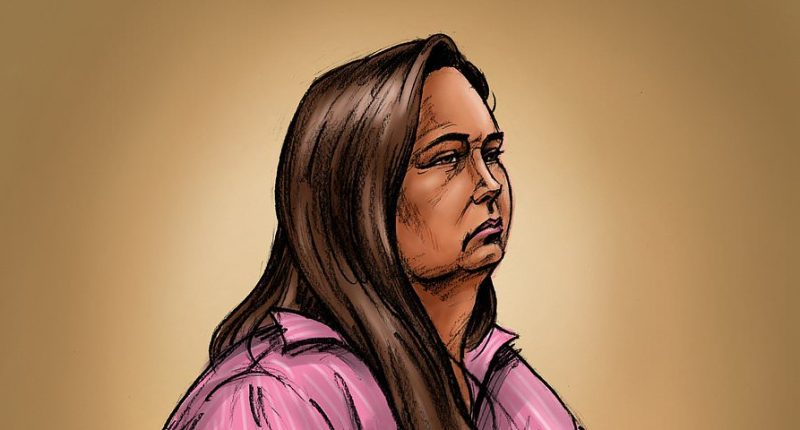
By PAUL SHAPIRO AND WAYNE FLOWER FOR DAILY MAIL AUSTRALIA
Published: | Updated:
Follow Daily Mail Australia’s live coverage of accused mushroom chef Erin Patterson ‘s murder trial at Latrobe Valley Magistrates’ Court in Morwell, Victoria.
‘General public has a poor ability to identify wild mushrooms’
Dr Tom May told the jury the ‘general public has a poor ability to identify wild mushrooms’.
Patterson, wearing all black and glasses, stared ahead and listened intently to her legal team undertake cross-examination of the fungi expert.
Dr May also agreed with a defence suggestion that ‘it takes a long time to accurately learn how to identify mushrooms in the bush’.
The world-renowned mushroom expert agreed death caps varied in appearance and had characteristics including smooth caps which can be greenish, yellowish, white or brown in colour.
He said death caps may or may not have spots, a white or light-coloured stem, white gills, and a cup at the base which is not always visible.
Dr May said the ring stem is not always visible.
‘I would be looking for all of those features to be present (to identify a death cap),’ he said.
Dr May said to be certain the mushroom was a death cap, he would need a specimen or a sample to do spore print and DNA testing.
He also agreed with a defence suggestion that ‘on sight alone, it’s not possible to identify a death cap mushroom’.
Dr May said if he was out walking with naturalists, he said he could informally spot a mushroom and say ‘that’s a death cap’.
The expert said he needs more thorough findings and evidence when formally identifying a death cap to The Victorian Poisons Information Centre.
Dr May said he can also rule out a mushroom being a death cap by only seeing a partial number of characteristics.
‘Sometimes if I can see only some of the features, I can rule out it being a death cap,’ he said.
Dr May said he has identified about 30,000 mushrooms including the death cap pictured below that he has posted to iNaturalist.
Fungi expert on death cap mushrooms
Mycologist Tom May (pictured below), who is an internationally recognised fungi expert, yesterday told the jury death cap mushrooms can only be found beneath or close to oak trees or trees within the oak family.
Dr May, a mushroom expert who was the principal fungi research scientist at the Royal Botanical Gardens, said death caps had a ‘symbiotic’ relationship with oak trees.
The mushroom expert, who will continue answering questions under cross-examination this morning, described death caps as mostly orangey in colour, but could be whiteish or brownish.
He said they change their appearance as they matured.
Dr May told the jury death cap mushrooms – known scientifically as amanita phalloides – were believed to have been accidentally introduced into Australia from Europe and were first detected in Victoria in the 1970s.
He said the mushrooms were ‘relatively short lived’ in the wild due to wet conditions and insects.
Dr May said death caps wouldn’t last much longer in a refrigerator due to the fungi being infested with insects that ‘keep working away’ at the mushrooms.
Dr May said there were many publicly available online databases that contained information regarding death cap mushrooms.
He said iNaturalist is Australia’s largest publicly accessible citizen scientist app for uploading information about fungi.
Dr May told the jury you need an account to post information about wild mushroom, but don’t need an account to view ‘precise location information’.
‘You can readily find the location of certain species,’ he said.
The jury heard a death cap was detected in Loch on April 18, 2023.
The doctor said death cap mushrooms have been found in the ACT, NSW and parts of Victoria, including Gippsland towns Outtrim, Loch and Morwell.
In Victoria, death caps grow throughout metro Melbourne to the east into the Dandenong Ranges and in the west to Gisborne and Bendigo, the jury was told.
Dr May said cases involving death cap mushrooms occured when people ingested the deadly fungi by mistake.
Dr May, who published a book in 2021, told the jury toxins found in death caps can be in found other mushrooms.
In 2023, one poisoning involved a Chinese tourist who ate a mushroom, became sick, went to hospital, showed early signs of organ failure, but left hospital a week later.
In 24 other cases of reported wild mushroom poisonings, patients experienced gastro symptoms, but none involved organ damage.
Patterson trial overview
Accused mushroom murderer Erin Patterson, 50, last week witnessed both her children’s recorded video evidence.
Patterson, who is accused of murdering her in-laws, Don and Gail Patterson, and Gail’s sister, Heather Wilkinson, after serving them a deadly meal laden with death cap mushrooms, became emotional after seeing video evidence from her son and daughter.
Patterson is also accused of attempting to murder Heather’s husband, pastor Ian Wilkinson who survived the lunch after spending several weeks in an intensive care unit.
The court heard Patterson’s estranged husband, Simon, was also invited but didn’t attend.
Witnesses told the jury Patterson ate her serving from a smaller and differently coloured plate than those of her guests, who ate from four grey plates.
Patterson told authorities she bought dried mushrooms from an unnamed Asian store in the Monash area of Melbourne, but health inspectors could find no evidence of this.
The health department declared the death cap poisoning was ‘isolated’ to Patterson’s deadly lunch.
Multiple witnesses including Simon Patterson, Ian Wilkinson and other family members have given emotion-charged evidence to the jury.
Medical staff have told the jury of the horrifying symptoms the dying lunch guests and Ian Wilkinson suffered.
Patterson’s movements at hospital and her abrupt departure have also been aired in court as the trial continues this morning.
Share or comment on this article:
Erin Patterson mushroom murder trial LIVE updates: Fungi expert under cross-examination








